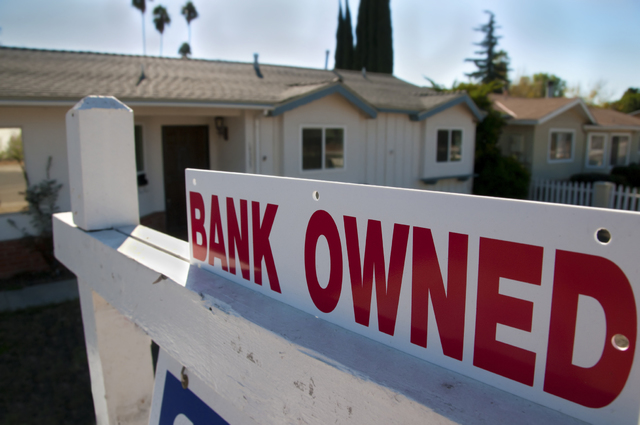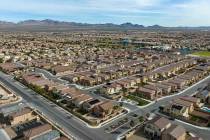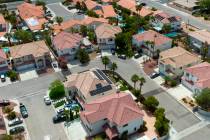Minority neighborhoods in Las Vegas have higher share of underwater borrowers, report shows
Minority neighborhoods in Las Vegas and other cities have higher shares of underwater borrowers than white areas, sometimes more than double or even triple the rate, a new report shows.
An estimated 10.9 percent of U.S. homeowners with mortgages were underwater — meaning their debt outweighed their home’s value — in the third quarter, according to home-listing service Zillow.
Las Vegas’ rate, 16.8 percent, was second-highest among the metro areas listed in the report, behind Chicago.
Across the country, though, underwater rates can vary greatly from one neighborhood to the next, Zillow found, in the latest report to highlight gaps in housing for white and minority families in Southern Nevada and elsewhere.
Upside-down mortgages are “a persistent reminder of the housing crash,” Zillow said, and few places were hit as hard as Las Vegas, ground zero for America’s real estate boom and bust.
But after the market crashed, homes in predominantly black and Hispanic communities lost more value than those in mostly Asian or white areas, according to Seattle-based Zillow. Rising home values have helped borrowers nationwide escape negative equity, but “black and Hispanic communities have not had as strong of a recovery.”
Nationally, 9.9 percent of borrowers in mostly white areas are upside-down, compared with 20 percent in predominantly black communities and 12 percent in mostly Hispanic areas, Zillow found.
In Las Vegas, 13.4 percent of borrowers in predominantly white areas are underwater, compared with 26.5 percent in mostly Hispanic communities. Zillow did not publish a rate for the valley’s predominantly black areas.
Not every metro area in the report had data for each segment of the population. But according to Zillow, which said it examined U.S. Census tracts to help compile its findings, white areas typically have lower-than-average rates of underwater borrowers, while minority neighborhoods’ rates are usually higher than average.
Here’s a look at some other cities:
■ Chicago (overall 17 percent): white, 13.8 percent; black, 28.2 percent; Hispanic, 22.8 percent
■ Detroit (overall 12.2 percent): white, 9.5 percent; black, 35.1 percent
■ Atlanta (overall 13 percent): white, 8.3 percent; black, 27.7 percent
■ Phoenix (overall 11.2 percent): white, 10.2 percent; Hispanic, 14.7 percent
■ Orlando, Florida (overall 11.4 percent): white, 9.4 percent; black, 20.8 percent; Hispanic, 14.1 percent
■ Indianapolis (overall 12.8 percent): white, 11.8 percent; black, 22.9 percent
All told, underwater borrowers “are stuck in their homes,” crimping the inventory of properties for sale, Zillow said in the report.
Unless their house rises enough in value to push them above water, upside-down owners typically can sell only through a short sale, in which the bank agrees to sell the house for less than what’s owed on the mortgage, a potentially long process that has no guarantee of being approved.
“These gaps can and will have long-lasting implications for growth and equality,” Zillow chief economist Svenja Gudell said in the report.
It’s not the only area of housing with race-related gaps.
Housing advocates last month sued mortgage giant Fannie Mae, alleging a “stark pattern of discriminatory conduct” over its upkeep of foreclosed homes in Las Vegas and dozens of other metro areas.
Fannie Mae’s foreclosed properties in mostly white neighborhoods were “far more likely” to have their lawns mowed and edged regularly, weeds and vines cleared, windows and doors secured or repaired, trash removed, leaves raked and graffiti erased, the groups claimed.
Homes in mostly black and Hispanic neighborhoods, however, were “more likely to be left neglected” with trash and debris on the property, overgrown grass and invasive plants. Also, windows and doors were often unsecured, left open or boarded up, they alleged.
Fannie Mae has said that it strongly disagrees with the allegations and that its maintenance standards for foreclosed homes “are designed to ensure that all properties are tended to and treated equally.”
Meanwhile, Zillow reported in November that, around the country, minority mortgage loan applicants had much higher rates of denial than whites.
Nationally, 10.4 percent of applicants for conventional mortgages were denied in 2015. Some 8.7 percent of white applicants were rejected, compared with 11.1 percent of Asian applicants, 17.3 percent of Hispanic applicants and 22.4 percent of black applicants, according to Zillow, citing federal data.
In the Las Vegas area, 12.8 percent of all applicants were rejected in 2015. Some 10.3 percent of white applicants were denied, compared with 13.3 percent of Hispanic applicants, 15.6 percent of Asian applicants and 17.3 percent of black applicants.
Contact Eli Segall at esegall@reviewjournal.com or 702-383-0342. Follow @eli_segall on Twitter.




























